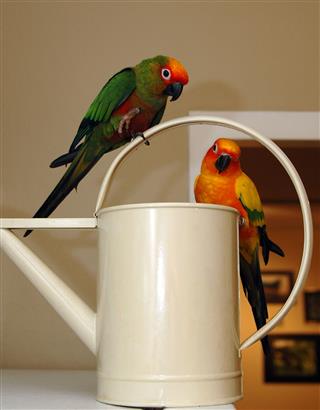
A green cheek conure is the perfect choice of parrot, that you can get into your home. Find out here on how to take care of it, and what needs to be followed to keep it healthy, and content…
A green cheek conure has a distinct appearance that makes it stand out from the rest. Its vibrant shades of color fan out in rainbow like sequences, with a thick coat of feathers with features that are true to its name. These parrots have black beaks, brown eyes that fall on the darker side and white ringed eyes. The top of its head usually spots either a black or dark gray hue, whereas the ears are gray, and the cheeks are, as the name suggests, green.
There’s a lot of blue tracing around its feathers, and some of it also courses down its tail region, which is a deep dark maroon. Their bellies are also maroon in color, although not all of them come in this color. Green cheeks are also called green cheeked parakeets, and find their origin in parts of Brazil, west central and southern Mato Grosso, and in some parts of Argentina and eastern Bolivia.
Forested areas are their breeding grounds, where most of these parrots are endangered when it comes to their natural surroundings. They make good household pets, and can be a nice addition to an already growing clan of pets that you may already have. There are things to be kept in mind when going by green cheek conure care, which you will find out soon enough.
Green Conure Behavior
This type of parrot is a very social bird, and extremely fun to be around with, since they do well in an environment that calls for constant attention and grouping.
- Although vocabulary is limited, they do have some words that they can recall and repeat if heard on a regular basis.
- They’re smart birds that are very playful in nature.
- They can bite those who try to touch them, but this happens mostly when they’re young. Overtime this can cease completely once they grow up.
- Tricks are their forte, where they’ll perform many of these on several occasions.
- They aren’t as loud as other kinds of conures, so keeping them indoors won’t be all that bad.
Additional Information
Important Details
If a green cheek conure is kept confined only to his/her cage, they can turn aggressive and start mutilating themselves, changing their moods if not comfortable with their surroundings. It is important to provide it a well spaced out cage that gives it ample room to fly around and stretch in. Toys are another important addition to the cage. Provide hanging bars, and little parrot knick knacks that he/she will enjoy passing their time with.
Let it out of the cage once in a while, but make sure that all windows are closed and fans that are on, are immediately switched off. It is imperative to feed your parrot the right kind of food, and provide for it nutrients that it needs on an everyday basis. Without the appropriate supply of these foods, it changes its behavioral traits, where the wrong eatables can truly hamper its health in the long run.
They can live up to 25 years at a stretch, but can come down drastically if not taken care of in the right manner. Make sure cages have bars that aren’t widely spaced for the parrot to stick its head out of, since this can in the long haul prove to be injurious to their tiny heads.
Quick Facts
Do not feed your green conure food that can alter its health state, since the wrong kinds can seriously damage their systems. Eliminate pellets that are coated in a colored sugar encasing, since these can lead to a serious sugar overload, that isn’t right for a parrot’s diet. It is important to take your parrot to a veterinarian every now and then to have it checked out for any illnesses and problems.
Be careful what you spray around your home, since these birds are sensitive to strong aromas and aerosol sprays. Cookware cleaning ovens that are non-stick in nature can also prove to be deadly to a bird, so make sure none of this is present in the parrot’s zone. Be careful about what it chews, since when it is released out of its cage, he/she can find random things to pick at and possibly swallow/choke on. Provide toys like bird kabobs, hanging apparatuses, swings and soft wood chew toys, for its entertainment.
These parrots like to whistle, so encourage them to do so by playing a CD that has whistling on it. They need bathing every once and a while, so make sure you keep a nice big bowl full of water for it to clean itself in, and change it every now and then once the parrot’s done. Keep it constantly interacting with either yourself or a second parrot, since they get easily bored, and moody if not kept busy.
As for the diet, it is important to understand that not all foods are safe for your bird to munch on. So here’s a list of safe foods that you can cut up and store, for your parrot.
- Dandelions
- Apples (seedless)
- Sweet potato
- Carrots
- Broccoli
- Kale
- Grapes (seedless)
- Peas
- Corn kernels
- Spinach
A green cheek conure is a nice bird to have around the house, that is both sociable and loving as a pet. So before you get this guy, make sure you do ample research about care tips and guidelines, so that you know what you’re getting yourself into.




